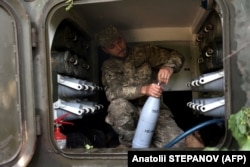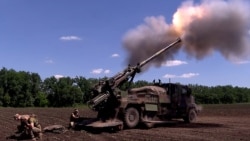As questions mount about the extent of European support for Ukraine, the leaders of France, Germany, Italy, and Romania met with Ukrainian President Volodymyr Zelenskiy in a show of unity in Kyiv.
The June 16 visit by French President Emmanuel Macron, German Chancellor Olaf Scholz, Italian Prime Minister Mario Draghi, and Romanian President Klaus Iohannis comes as Ukrainian officials continue to call for heavier weapons to help offset Moscow's firepower advantage that has allowed Russian forces to extend their grip into Ukraine's Donbas region.
While the eastern provinces of Donetsk and Luhansk have been a focus since Moscow's February 24 invasion, Russian forces have concentrated their attack there in recent weeks and redirected forces toward the Ukrainian twin cities of Syevyerodonetsk and Lysychansk. The bridges connecting the two cities have recently been destroyed and tough, street-to-street fighting is raging in Syevyerodonetsk, where thousands of civilians are also trapped and facing constant artillery barrage in what is proving to be one of the deadliest battles so far in the war.
As that fighting continues, the war has also raised tough and far-ranging questions for the European Union, with its leaders forced to grapple with its broader fallout, from rising energy prices, a simmering global food crisis, inflation, and a massive refugee crisis.
To find out more about the calculus on the battlefield and what to expect from Ukraine's backers, RFE/RL spoke with Chris Dougherty, a former U.S. defense official and fellow at the Center for a New American Security, a Washington-based think tank.
RFE/RL: In the lead up to the NATO ministers meeting and Western leaders going to Kyiv, we've seen Ukrainian officials speak plainly that they need more weapons and ammunition in order to win against Russia. How likely does it seem to you that Kyiv will get what it is asking for and get it delivered to the battlefield where it can have an impact in a timely way?
Chris Dougherty: I do think they will get much of what they're asking for. Although the supplies will likely have to come from places like the United States or the United Kingdom. I don't think you're going to get as much from some of the Eastern European allies because they've given so much of their already limited stocks -- and their stocks of Western supplies are relatively low. They originally sent a lot of their older Soviet-era equipment to the Ukrainians and there's just increasingly small amounts of that left in stock that can be sent to the battlefield.
The real question is if it can arrive on the battlefield in a relevant timeline and there's really several factors to that.
One is a back-end factor, meaning how long does it take for these Western governments to agree and then have those orders work their way down through the bureaucracy? Then there is ensuring that the weapons actually get on transits across the Atlantic and all the logistical things you need to get right so [they're] in Ukraine. So how long transit takes is a big piece affecting the timeline. Then the last piece is an integration issue for the Ukrainian military.
I think that's one of the areas where we're seeing a lot of hang-ups. It's one thing to provide someone with a weapon system, but it's another thing to train them on how to use it and also be effective. [Plus] it's a whole other thing to train them on how to sustain that weapon system over time and coordinate its effects with the effects of all the other new weapons systems that the Ukrainians are trying to bring into their armed forces right now.
The Ukrainians are trying to do this under battlefield conditions and with forces that are made up increasingly less of the experienced corps of fighters that have been fighting in Ukraine since 2014. Those troops are starting to become casualties of war and so you've got this concatenation of difficult challenges -- from political agreements down to tactical usages and personnel problems -- facing the Ukrainians and that's going to make it hard for these weapon systems to be integrated.
Now with that all being said, I do think that they can be integrated, but in all likelihood on a timeline of months, not weeks.
For example, the high-mobility artillery rocket systems (HIMARS) provided by the United States to the Ukrainians will probably arrive sooner because the decision has already been made that the shipment can go out. For the United States, if we really want to get something there fast, it gets put on a C-17 aircraft and it can get there in a matter of days rather than weeks. But if you're shipping things out by boat, you've got to consider that transit time and all the intermediate transit points that that item has to also pass through.
RFE/RL: Where does that leave us if you're talking about a timeline of a few months? Zelenskiy said recently that the fight under way now in the Donbas will shape the future of the war and that Ukraine is trying to wear down Russia with these attritional battles. Can that work as a strategy and is it sustainable given the timelines you just discussed?
Dougherty: I think that depends on a handful of factors.
One is how long can Russia sustain this sort of mass artillery barrage on three fronts that we're seeing in Kharkiv, then in the Donbas -- especially with Syevyerodonetsk right now -- and then another front down in Kherson.
In each of those, you see a heavy application of Russian firepower, which is something that the Russians have designed their forces for. This focus on heavy artillery is how Russian doctrine is designed to operate and it's meant to allow them to destroy enemy cities and any points of difficulty Russian troops might face. So, when you hear commentators sometimes saying that the Russians just are unprofessional because they are attacking cities, it couldn't be further from the case. From the Russian perspective, it was very much their plan and it's definitely a feature and not a bug.
So, the question is then how long can Russia sustain that and I think you see pretty clear evidence of difficulties on the Russian side, particularly in terms of equipment and personnel.
We're already seeing Russian trains filled with equipment coming out of storage and its oftentimes older equipment. The Russians are essentially going back to the warehouses and pulling them out of storage, while also trying to scrounge up additional forces from deep inside Russia. They're also trying to sign up whoever they can to enlist.
The difficulty with that is that those forces are not going to be very coherent. They're probably not going to be very familiar with the weapon system that they're operating and they're going to be thrown into the front. So, there are difficulties on the Russian side in terms of how long they can sustain operations like that without actually calling for a wider mobilization.
Also, because they're on the offensive in most places right now, they face some coming difficulties. It's not just about your ability to fight at the front, it's also once you're at the front do you have the reserves and the additional manpower necessary to drive through whatever gap you've created into enemy territory? And the answer thus far for Russia is "no."
RFE/RL: Both Ukrainian and Western officials have said that Ukrainian troops are outgunned and exhausted. Even if Russia faces problems too, how can Kyiv regroup?
Dougherty: In the short term it really comes down to manpower.
The Ukrainians are running low on artillery shells and I think the artillery battles matter, but I don't think that there's any way for the Ukrainians to meaningfully win a symmetrical artillery duel with the Russians. So, it really comes down to how long can the Ukrainians hold out on these three fronts and can they hold out long enough that those weapons systems can actually arrive and be effective on the battlefield.
If they can do that, I think they've got a hope of holding on to some of these territories and maybe even making some limited counterattacks. Although again, much like how the Russians face these personnel and equipment shortfalls, the Ukrainians face similar problems. They just don't have enough in reserve in terms of trained soldiers or equipment to make a big gain when they poke a hole in the Russian lines.
Finally, there's the wider political and economic sustainability of the war.
On the Russian side, this is how long can [Russian President Vladimir] Putin and his regime continue what they call a "special military operation" rather than really declaring this an actual war and mobilizing their population.
On the Western side, how long can this coalition -- which is pretty solid so far, although with some clear exceptions -- keep supplying Ukraine with intelligence, weapons, and supplies? How long can that stay together?
We're already seeing interest across the West in Ukraine declining, which is evident in things like Google searches and front-page media coverage. Inside Russia, it's obviously harder to calculate public opinion and also the internal opinions of folks in the Kremlin, but one can imagine that there [are] tough questions being asked, although we're not sure whether they're happening out loud or not.
So, this comes down to which side can sustain the war politically and economically and provided the Ukrainians can hold on in the areas where there's fighting now, that will be an increasingly prominent question throughout the rest of the summer and into the fall and winter.



















